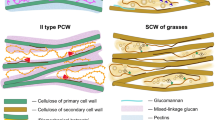Summary
To determine whether the expression of cell wall related genes changes during the establishment of an arbuscular mycorrhizal symbiosis (AM), we studied the expression of a maize hydroxyproline-rich glycoprotein (HRGP) gene. In situ hybridization showed that, in differentiated cells of maize roots, mRNA accumulation corresponding to the gene encoding for HRGP was only found when the cells were colonized by the endomycorrhizal fungusGlomus versiforme.
Similar content being viewed by others
References
Balestrini R, Romera C, Puigdomenech P, Bonfante P (1994) Location of a cell-wall hydroxyproline-rich glycoprotein, cellulose and β-1,3-glucans in apical and differentiated regions of maize mycorrhizal roots. Planta 195: 210–209
—, Hahn MG, Mendgen K, Faccio A, Bonfante P (1996) Differential localization of carbohydrate epitopes in plant cell walls in the presence and absence of arbuscular mycorrhizal fungi. Plant Physiol 111: 203–213
Benhamou N, Mazau D, Esquerré-Tugayé MT (1990) Immunocytochemical localization of hydroxyproline-rich glycoproteins in tomato root cells infected byFusarium oxysporum f. sp.radicislycopersici: study of a compatible interaction. Mol Plant Pathol 80: 163–173
Blee KA, Anderson AJ (1996) Defence-related transcript accumulation inPhaseolus vulgaris L. colonized by the arbuscular mycorrhizal fungusGlomus intraradices Schenck & Smith. Plant Physiol 110: 675–688
Bonfante P (1994) Ultrastructural analysis reveals the complex interactions between root cells and arbuscular mycorrhizal fungi. In: Gianinazzi S, Schüepp H (eds) Impact of arbuscular mycorrhizas on sustainable agriculture and natural ecosystems. Birkhäuser, Basel, pp 73–87
—, Perotto S (1995) Strategies of arbuscular mycorrhizal fungi when infecting host plants. Transley Review no. 82. New Phytol 130: 3–21
—, Bergero R, Uribe X, Romera C, Rigau J, Puigdomenech P (1996) Transcriptional activation of a maize α-tubulin gene in mycorrhizal maize and transgenic tobacco plants. Plant J 9: 737–743
Esquerré-Tugayé MT, Lafitte C, Mazau D, Toppan A, Touze A (1979) Cell surfaces in plant-microorganism interactions II. Evidence for the accumulation of hydroxyproline-rich glycoproteins in the cell wall of diseased plants as a defence mechanism. Plant Physiol 64: 320–326
Franken P, Gnädinger F (1994) Analysis of parsley arbuscular endomycorrhiza: infection development and mRNA levels of defense-related genes. Mol Plant Microbe Interact 7: 612–620
Gianinazzi S, Schüepp H (eds) (1994) Impact of arbuscular mycorrhizas on sustainable agriculture and natural ecosystems. Birkhäuser, Basel
Gianinazzi-Pearson V, Gollotte A, Tisserant B, Franken P, Dumas-Gaudot E, Lemoine M-C, van Tuinen D, Gianinazzi S (1995) Cellular and molecular approaches in the characterization of symbiotic events in functional arbuscular mycorrhizal associations. Can J Bot 73 Suppl 1: S526-S532
Harrison MJ (1996) A sugar transporter fromMedicago truncatula: altered expression pattern in roots during vesicular-arbuscular (VA) mycorrhizal associations. Plant J 9: 491–503
—, Dixon RA (1994) Spatial patterns of expression of flavonoid/isoflavonoid pathway genes during interaction between roots ofMedicago truncatula and the mycorrhizal fungusGlomus versiforme. Plant J 6: 9–20
Hewitt EJ (1996) Sand and water culture methods used in the study of plant nutrition. Commonwealth Agricultural Bureaux, Farnhan Royal, Bucks, pp 187–285
Lambais MR, Mehdy MC (1995) Differential expression of defense-related genes in arbuscular mycorrhiza. Can J Bot 73 Suppl 1: S533-S540
Langdale JA (1993) In situ hybridization. In: Freeling M, Walbot V (eds) The maize handbook. Springer, Berlin Heidelberg New York Tokyo, pp 165–180
Lehrach H, Diamond D, Wozney JM, Boedtker H (1977) RNA molecular weight determination by gel electrophoresis under denaturing conditions, a critical reexamination. Biochemistry 16: 4743–4751
Logemann J, Schell J, Willmitzer L (1987) Improved method for the isolation of RNA from plant tissues. Anal Biochem 163: 16–20
Ludevid MD, Ruiz-Avila L, Valles MP, Stiefel V, Torrent M, Tornè JM, Puigdomenech P (1990) Expression of genes for cell-wall proteins in dividing and wounded tissues ofZea mays L. Planta 180: 524–529
Ruiz-Avila L, Ludevid MD, Puigdomenech P (1991) Differential expression of a hydroxyproline-rich cell-wall protein gene in embryonic tissues ofZea mays. Planta 184: 130–136
Stiefel V, Ruiz-Avila L, Raz R, Vallès MP, Gomez J, Pagés M, Martinez-Izquierdo JA, Ludevid MD, Langdale JA, Nelson T, Puigdomenech P (1990) Expression of a maize cell wall hydroxyproline-rich glycoprotein gene in early leaf and root vascular differentiation. Plant Cell 2: 785–793
Torres MA, Rigau J, Puigdomenech P, Stiefel V (1995) Specific distribution of mRNAs in maize growing pollen tubes observed by whole-mount in situ hybridization with non-radioactive probes. Plant J 8: 317–321
Vera P, Lamb C, Doerner PW (1994) Cell-cycle regulation of hydroxyproline-rich glycoprotein HRGPnt3 gene expression during the initiation of lateral root meristems. Plant J 6: 717–727
Volpin H, Phillips DA, Okon Y, Kapulnik Y (1995) Suppression of an isoflavonoid phytoalexin defence response in mycorrhizal alfalfa roots. Plant Physiol 108: 1449–1454
Wycoff KL, Powell PA, Gonzales RA, Corbin DR, Lamb C, Dixon RA (1995) Stress activation of a bean hydroxyproline-rich glycoprotein promoter is superimposed on a pattern of tissue-specific developmental expression. Plant Physiol 109: 41–52
Author information
Authors and Affiliations
Rights and permissions
About this article
Cite this article
Balestrini, R., Josè-Estanyol, M., Puigdomènech, P. et al. Hydroxyproline-rich glycoprotein mRNA accumulation in maize root cells colonized by an arbuscular mycorrhizal fungus as revealed by in situ hybridization. Protoplasma 198, 36–42 (1997). https://doi.org/10.1007/BF01282129
Received:
Accepted:
Issue Date:
DOI: https://doi.org/10.1007/BF01282129




